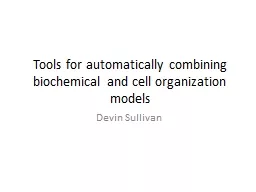

Devin Sullivan Motivation Fluorescence microscopy provides a tool for understanding the impact of spatial organization on the biochemistry of cells Simulating biochemical systems within these geometries can improve our understanding of these systems ID: 915161
Download Presentation The PPT/PDF document "Tools for automatically combining bioche..." is the property of its rightful owner. Permission is granted to download and print the materials on this web site for personal, non-commercial use only, and to display it on your personal computer provided you do not modify the materials and that you retain all copyright notices contained in the materials. By downloading content from our website, you accept the terms of this agreement.
Slide1
Tools for automatically combining biochemical and cell organization models
Devin Sullivan
Slide2Motivation
Fluorescence microscopy provides a tool for understanding the impact of spatial organization on the biochemistry of cells.
Simulating biochemical systems within these geometries can improve our understanding of these systems.
Current methods of obtaining such geometries from images is not sufficient for accurately capturing the variability among cells
Slide3Benefits of generative models
Represents organelle localization, size and shape more accurately than segmentation
Provides a continuous space for synthesizing and subsequently analyzing changes in cell geometries
Slide4Object overlap avoidance
Idealized vesicular organelles should not overlap
By adjusting the core and render sizes we can select how much overlap is appropriate
Core
Rendered
Core
Rendered
Slide5Diffeomorphic model learning:
Non-rigid image registration
5
Target shape
Starting shape
1. Rohde G. K., Wang W.,
Peng
T., and Murphy R.F. (2008).
Slide6Diffeomorphic model learning:
Non-rigid image registration
6
Target shape
Starting shape
0.0165
0
0.0191
0.0194
0.0195
Distance
1. Rohde G. K., Wang W.,
Peng
T., and Murphy R.F. (2008).
Slide7Generating synthetic cells
Starting cell
7
Use multi-dimensional scaling to create “shape space”
Sample a point in this shape space
Generate synthetic cell by deforming nearby cells
Slide8Cell shape dynamics
How a cell might change over time
Increasing DNA intensity
time
Cell Shape
Slide9Exploring cellular parameter space
Sample modal instances
Sample outlier instances
Sample a sequence of instances
GMM of 3D
HeLa
shape space used for intelligent sampling
Slide10Cellular Systems Modeling:Previous approaches
10
Vastly simplified geometries
Neuronal EM
1
Manual segmentation
1
. Vazquez-Reina, A.,
Gelbart
, M., Huang, D.,
Lichtman
, J., Miller, E., &
Pfister
, H. 2011
Slide11High-throughput spatially realistic simulations
Study the effects of spatial variance caused by
Cell cycle
Diseases
Drugs
Inherent cell variance
Model large systems with high spatial realism
Validate generative model accuracies
11
Slide12CellOrganizer
Geometric
model
BioNetGen
Experiments
&
Literature
SBML
model
Mcell/VCell
Automation of spatial modeling
SBML-spatial
Slide13CellOrganizer
Geometric
model
BioNetGen
Experiments
&
Literature
SBML
model
Mcell/VCell
Automation of spatial modeling
SBML-
spatial+SBML
Step 1:
Biochemical systems modeling
Slide14Example system
354 reactions
78 species
7 “compartments”
Slide15Example system
354 reactions
78 species
7 “compartments”
Analyze the expression
leve
of P2
Slide16Why rule-based models
Rule-Based Modeling
30 rules
10 molecule types
Traditional Modeling
354 reactions
78 species
Slide17ODE modeling
Obtain a general idea of system behavior
Check simulation to confirm “reasonable” parameters/behaviors
Slide18CellOrganizer
Geometric
model
BioNetGen
Experiments
&
Literature
SBML
model
Mcell/VCell
Automation of spatial modeling
SBML-
spatial+SBML
Step 1:
Biochemical systems modeling
Step 2:
Creating realistic spatial geometries
Slide19Identifying compartments
Extract compartment information from SBML
Identify relevant models using string matching
Generate SBML-spatial instances with biochemistry and necessary geometries
Models:
Nuclear
Cell
Lysosome
Endosome
Mitochondria
MicrotubuleNucleosome
BNGL
SBML
CellOrganizer
SBML-
spatial+SBML
Slide20Installing CellBlender
Slide21Installing CellBlender
Slide22Installing CellBlender
Slide23Installing CellBlender
Slide24Importing SBML-spatial
Slide25Importing SBML-spatial
Slide26Importing SBML-spatial
Auto imports
G
eometries
AND
Biochemistry!
Slide27Make it pretty
Slide28Manual tuning
Fixing meshes
Must have consistent
normals
Must be manifold
Must be watertight
Partition use/tuning to speed up simulations
Increases speed >1000x!
Slide29CellOrganizer
Geometric
model
BioNetGen
Experiments
&
Literature
SBML
model
Mcell/VCell
Automation of spatial modeling
SBML-
spatial+SBML
Step 1:
Biochemical systems modeling
Step 2:
Creating realistic spatial geometries
Step 3:
Realistic spatial simulations
Slide30Whole cell simulations
Signal transduction network and geometry imported from SBML-spatial
Run for 100,000 steps of 10e-6s, 0.1s total
354 reactions, 78 species
Slide31Conclusions
Can build complex biochemical networks using Rule-based modeling (BNGL)
Can intelligently sample realistic cellular and organelle geometries
Can automatically combine biochemistry with appropriate geometric models
Can simulate whole cell bio-chemical systems in realistic geometries with minimal manual effort
Can now perform high-throughput spatial modeling of cells
Slide32Acknowledgments
Automation of simulations
Jose Juan Tapia
Jacob Czech
Rohan
Arepally
Markus
Dittrich
Advisor Robert MurphyCellOrganizer
Gregory JohnsonIvan Cao-Berg